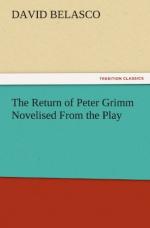“The Heart of Maryland” established both Belasco and Mrs. Carter. Then he started on that extravagant period of spectacular drama, which gave to the stage such memorable pictures as “Du Barry,” with Mrs. Carter, and “The Darling of the Gods,” with Blanche Bates. In such pieces he literally threw away the possibilities of profit, in order to gratify his decorative sense. Out of that time came two distinctive pieces—one, the exquisitely poignant “Madame Butterfly” and the other, “The Girl of the Golden West”— both giving inspiration to the composer, Puccini, who discovered that a Belasco play was better suited for the purposes of colourful Italian opera than any other American dramas he examined.
Counting his western vicissitudes as one period, and the early New York days as a second, one might say that in the third period David Belasco exhibited those excellences and limitations which were thereafter to mark him and shape all his work. There is an Oriental love of colour and effect in all he does; but there is no monotony about it. “The Darling of the Gods” was different from “The Girl of the Golden West,” and both were distinct from “The Rose of the Rancho.” It is this scenic decorativeness which has enriched many a slim piece, accepted by him for presentation, and such a play has always been given that care and attention which has turned it eventually into a Belasco “offering.” None of his collaborators will gainsay this genius of his. John Luther Long’s novel was unerringly dramatized; Richard Walton Tully, when he left the Belasco fold, imitated the Belasco manner, in “The Bird of Paradise” and “Omar, the Tentmaker.” And that same ability Belasco possesses to dissect the heart of a romantic piece was carried by him into war drama, and into parlour comedies, and plays of business condition. I doubt whether “The Auctioneer” would read well, or, for the matter of that, “The Music Master;” Charles Klein has written more coherent dialogue than is to be found in these early pieces. But they are vivid in mind because of Belasco’s management, and because he saw them fitted to the unique figure of David Warfield.
But a Belasco success is furthered by the tremendous public curiosity that follows him in all he does. There is a wizardry about him which fascinates, and makes excellent reading in the press. Long before I saw the three-winged screen upon which it is his custom to sort out and pin up his random notes for a play, it was featured in the press. So were pictures of his “collection,” in rooms adjoining his studio—especially his Napoleonic treasures which are a by-product of his Du Barry days. No man of the theatre is more constantly on the job than he. It is said that old John Dee, the famous astrologer whom Queen Elizabeth so often consulted, produced plays when he was a student at Cambridge University, with stage effects which only one gifted in the secrets of magic could have consummated. Belasco paints




